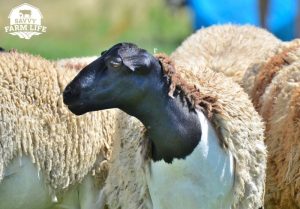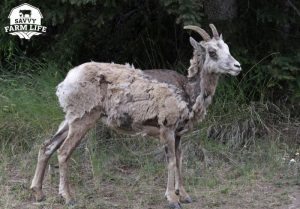
What To Know About Sheep Shedding
Shearing sheep can seem a daunting chore if you are inexperienced. Even though most sheep breeds need to be regularly shorn, they don’t like to be subjected to shearing, which makes the process more challenging. With other animals shedding their fur without intervention, you may be wondering why sheep cannot shed their wool when left to their own devices.
Why don’t sheep shed on their own? Wild sheep can, and do, shed their wool without intervention. But though there are some breeds of sheep that do not need to be sheared, most domestic wool sheep must be shorn annually. Wool-producing sheep have been selectively bred over the years to produce as much fleece as possible, with the result of this breeding eliminating the sheep’s ability to naturally shed its fleece.
Read on to learn more about how wild sheep shed their wool, the breeds of sheep that do not require annual shearing, and the consequences of neglecting the shearing process in wool-producing sheep.
How Do Wild Sheep Shed Their Wool?
Sheep were one of the first animals to be domesticated by humans, and have been walking alongside us for thousands of years. But sheep still have ancestors that are wild and live without human intervention – one of the most popular being the Rocky Mountain Bighorn. So how do wild sheep shed their wool on their own?
Two of the lesser-known cousins of the Bighorn are the Dall Sheep and the Stone Sheep. The Dall Sheep are native to the Yukon, Northern Territories, and Alaska, and have a pure white coat of fleece. The Stone Sheep are found primarily in British Columbia and the Yukon, and have a fleece that ranges from white to brown to black. Both of these sheep grow a coat of fleece that reaches about two inches in thickness – a coat that naturally molts every Summer.
These wool-producing sheep will scratch on tree trunks, bushes, and one another to shed this wool. The wool naturally protects them during the freezing Winters, sheds as the weather warms, and re-grows as the weather turns back to Winter. This is how nature designed sheep, and is how sheep would still be today if humans had not discovered the benefits that wool can provide them.
But what about the famous Bighorns? How do Bighorns shed their fleece? You may be surprised to learn that Bighorns do not actually produce wool at all – rather, they grow hair similar to that of a deer’s coarse hair. Rocky Mountain Bighorns can be found in the mountainous regions ranging from Southern Canada to Texas; while the Desert Bighorn can be found in the Southwest United States. While the US mountain ranges are cold, they are not the Yukon, and therefore Bighorns do not produce wool because it is not necessary for their survival.
While domesticated sheep may seem frightful and scaredy-cats, wild sheep are hardcore. To learn more about wild sheep, visit my article Can Sheep Survive In The Wild? Wool Growth and Behavior Facts.
Are There Any Domestic Sheep That Shed On Their Own?
There are two kinds of domestic sheep that shed on their own – hair sheep, and wool sheep that do not need to be shorn.
Hair Sheep Do Not Need To Be Shorn
There are several popular breeds of hair sheep, including the Barbados Blackbelly, the American Blackbelly, the Katahdin, the St. Croix, and the Blackhead Persian. Like the Bighorn, they have hair that is similar to the hair you would find on a deer, and they shed naturally as the seasons change. Many sheep farmers raise hair sheep for their meat and their milk, due to the low-maintenance nature of their coat.
Most hair sheep have been derived from sheep native to tropical regions, and so do not need the warmth that wool provides. In fact, wool would be detrimental to the sheep’s health in these areas of the world.
Some Wool Sheep Do Not Need To Be Shorn
While almost all wool-producing sheep need to be shorn, there are few breeds that are worth mentioning because of their ability to shed naturally.
Icelandic Sheep – these beautiful sheep grow long fleece, and naturally go through a process called “wool break” every year. During this period, their fleece will begin to shed on its own. The process is not a quick one, and Icelandic sheep will often look patchy for a while. For this reason, many farmers who raise Icelandic sheep will help them out by “rooing” – which is a simple method of pulling out the fleece after it begins to shed.
While Icelandic sheep shed on their own, you can shear them twice a year if you are raising them specifically for their wool (it is more challenging to process and sell fleece if you are having to collect it from random spots in the pasture).
Wiltshire Horn Sheep – the Wiltshire Horn is an older breed of sheep native to southwestern England. They have a soft coat that is a combination of fine hair and wool. Because they have a combination coat, they shed this fleece naturally every Spring. Wiltshire Horns were used in the development of several hair sheep, including the Katahdin.
California Red Sheep – the California Red is another breed of sheep that, like the Icelandic, can be sheared regularly for those raising them specifically for their fleece. However, many California Reds do not need to be sheared, and shed naturally. This is due to the unique coat of oatmeal-colored wool that is mixed with fine red hairs. The breed was developed by crossing the Barbados Blackbelly and the Tunis.
Dorper Sheep – the Dorper is a popular meat-producing breed that is unique in that not one Dorper coat is the same. Some Dorpers produce hair, and some produce wool. Some Dorpers shed on their own, while some shed only the wool on their bellies, legs, and face (leaving only the back, or body, to shear). If you are considering raising Dorpers because of their low-maintenance fleece (or hair), make sure that you speak with the breeder about the coats of their specific flock.
What Happens If You Don’t Shear Your Sheep?
 Have you heard of Shrek the sheep? Shrek was a Merino sheep that escaped before shearing day and successfully evaded capture for the next 6 years by living in a cave in New Zealand. This sheep is famous because when he was finally found in 2004, he had over 60 pounds of fleece shorn from him. Another sheep, named Chris from Australia, shared a similar fate and when found feral in 2015, had a whopping 88 pounds of fleece shorn from his body after his discovery.
Have you heard of Shrek the sheep? Shrek was a Merino sheep that escaped before shearing day and successfully evaded capture for the next 6 years by living in a cave in New Zealand. This sheep is famous because when he was finally found in 2004, he had over 60 pounds of fleece shorn from him. Another sheep, named Chris from Australia, shared a similar fate and when found feral in 2015, had a whopping 88 pounds of fleece shorn from his body after his discovery.
While these were incredible stories, the truth is that if Shrek and Chris had continued to live in the wild they would have died because of their overgrown fleece. There are several hazards that can follow a neglected wool-producing sheep.
Overheating Sheep
The most obvious consequence of neglectful maintenance is overheating. Imagine wearing a wool jacket in the Summer – now imagine that wool jacket continuing to get thicker and thicker every month. Depending on the climate, a sheep with an overgrown fleece (or even a mature fleece) can quickly overheat and die during a hot spell. Unless your sheep sheds on its own, you should be shearing every Spring.
Sheep Hygiene
If you have a dog that visits the groomers, you know what a sanitary trim is. Sheep that are not shorn regularly become very… unsanitary. Their wool will quickly become covered in urine and feces. This becomes particularly hazardous when one considers the pests that are attracted to this type of environment. Sheep can succumb to parasites and flystrike quickly if left in this condition.
Sheep And Mobility
Other concerns can arise if a sheep is left unshorn. The weight of the fleece will affect their mobility and will make them more susceptible to predators. They can fall down and roll onto their backs, becoming stuck and unable to right themselves. And they can become “wool blind” – suffering from impaired vision due to the excess fleece around their eyes.
Did you know sheep are a lot like turtles in the fact that they can get stuck on their backs and die? To learn more, visit my article Sheep Falling Over: Causes, Preventions, & Tips.
Why Do Sheep Grow Endless Amounts Of Wool?
While sheep were originally domesticated for their meat and milk, farmers eventually realized that they can benefit from sheep’s wool as well. They began using this wool to make clothing and other textiles, providing them a way to stay warmer in the cold weather. Humans then began breeding sheep for wool production – breeding the sheep that had the thickest, longest wool. This selective breeding eventually led to a sheep that grows thick fleece endlessly. This type of selective breeding is no different than the selective breeding we perform for all other domesticated animals, and has provided humans with fast-growing poultry, leaner and larger pigs, and dogs that can be used for a variety of different purposes.
Some Sheep Shed On Their Own; Most Don’t
Because of the nature of the wool industry, most sheep will continue needing to be shorn on a regular basis. If you are interested in raising sheep for meat or milk, but hesitant to dive into shearing, fortunately there are a handful of hair breeds and combination breeds that you can choose from.
Shearing is just one aspect of sheep care you’ll need to know if you plan on raising sheep. To learn more about caring for sheep, visit my article How To Care For Sheep: Essential Guide For Beginners.
